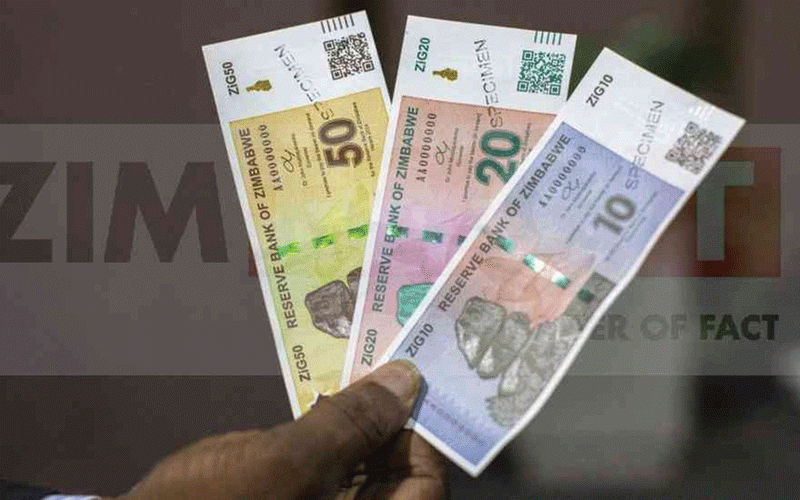
PRICES for goods and services in the market have skyrocketed in the past month, with the market exchange rate now approaching US$1: ZW$2 000.
The market rate shows a wide variance from the soft pegged official exchange rate, which is currently on US$1:ZW$1,021. Independent analysts widely estimate that Zimbabwe’s annual inflation has yet again breached 500% for April 2023.
The last published annual inflation figure for the local currency was 229,8% in January 2023.
The increase in the rate of inflation points to the deafening impact of the depreciating exchange rate on the local economy with prices for consumer goods and services closely aligned to the market exchange rate.
Inflation forecasts off rails
In announcing the 2023 national budget in December 2022, the government simply set a month-on-month inflation target range of between 1% to 3% as the target for December 2023.
It avoided stating an annual inflation forecast after recurring disasters where optimistic forecasts exposed the government’s dismal failure to restore local currency stability and reign in on money supply growth by the powerful central bank.
However, on forward guidance with regards to interest rates, the central bank pointed that policy rates are expected to be aligned to the implied Zimbabwean dollar inflation path of between 30%-60% by end of 2023.
- Key drivers of inflation in Zim
- Currency crisis cripples women’s savings clubs
- Budget highlights
- Annual inflation seen below 5%
Keep Reading
Inflation data secrecy
Through the promulgation of Statutory Instrument (SI) 27 of 2023, Zimbabwe abandoned publication of month-on-month and annual inflation figures in local currency in favour of a lower blended inflation (weighted average of local currency and US dollar prices).
The adoption of blended inflation largely serves as a political narrative that inflation is declining especially in an election year despite the fact that Zimbabwean dollar prices are skyrocketing daily on the market and the local currency is tumbling in value.
Ideally, the Zimbabwe National Statistics Agency (Zimstat) should publish consumer price indices in the local currency, in US dollar and in their preferred blended form so that businesses and various stakeholders pick what is relevant to them.
The blended inflation figure serves no purpose for referencing or accounting purposes as goods and services are purchased in one currency, (either local or foreign currency) not a cocktail of currencies in one transaction.
It is key to point out that the central bank does not issue foreign currency and has no control on its circulation or inflation rate hence any claim of stabilising inflation through adoption of a blended rate is misleading.
US dollar inflation figures are not a result of any central bank or government efforts.
Money printing, quasi fiscal activities
There is no doubt that the major driver to inflation in Zimbabwe and source of economic stability is money printing by the central bank. In the first quarter of 2023, broad money supply has ballooned from ZW$2 338 trillion on January 1 to an estimated ZW$4 000 trillion currently.
In 2022, broad money grew by 391,88% on an annual basis, an increase from 131,6% realised in December 2021.
However, much of the growth can be attributed to the impact of local currency depreciation which means that the foreign currency component in local bank accounts yields more in local currency value at revaluation.
The central bank mainly prints to credit exporters for retained export earnings (25% of all exports) and local foreign currency deposits (15% of all domestic deposits) since it requires foreign currency to service its offshore debts and finance government offshore expenditure.
In addition to the above, direct payments for agriculture inputs and payments for delivered agriculture commodities (maize, wheat, soya, and cotton) have a direct effect on increasing money supply growth.
These facilities are largely motivated by political motives; hence it is difficult to separate monetary policy and political influence. The astronomic growth in money supply has been the biggest contributor to artificial demand for foreign currency and local currency depreciation.
The growth has fuelled reports of foreign exchange dilution in the local market as the country prepares for the harmonised elections to be held on or before August 2023.
Undoubtedly, the above events will result in an increase in foreign currency withdrawals from the banking sector and increase in the exchange premium from USD Nostro to USD Cash.
Foreign exchange regulations
Artificial demand for foreign currency is also caused by stringent foreign exchange policies where the central bank controls the exchange rate and allocates foreign currency.
The mechanism suppresses free market price discovery and creates arbitrage opportunities for holders of foreign currency. Thus, it is in the best interest of those with privileged access to foreign currency or non-productive beneficiaries of the auction allocations to see the Zimbabwean dollar depreciate to earn more profits.
Critically, the intervention of the central bank in pegging the exchange rate means that holders of foreign currency (mainly exporters and informal traders) do not see value in off-loading excess foreign currency on the formal market.
Foreign currency accounts (FCA) deposits with local banks have remained stable at about US$1,5 billion and the trend is likely to be sustained provided the auction rate remains pegged well below the market rate as has been the case since its inception.
The auction exchange rate falls short in reflecting economic dynamics, such as the current account balance, money supply, foreign investments, and confidence.
Added to this, the amount to be auctioned in each week is not known before hand, which means the auction virtually trades weeks ahead for foreign currency which is not available.
This means the amounts traded or allotted in each week are plucked off head with limited input on foreign currency availability. Delays in settlement create malpractices where winning bidders can use their local currency while waiting for their allotments.
The central bank must emulate basic tenets of foreign currency management as foreign currency allocation is a prerogative of commercial banks and the apex bank intervention is only done through policy or open market instruments to mop up excess liquidity.
Huge import bill
Zimbabwe’s import bill remains outsized due to the need to augment limited local production of intermediate goods and agriculture commodities.
Imports for the three main agriculture commodities (maize, wheat, and soya) cost the country at least US$500 million per year for the last seven years.
This is before processed cereals and other agricultural commodities are factored into the import equation. Similarly, the local industry imports close to 80% of raw materials needed to produce consumer goods.
The huge import bill leads to imported inflation due to the prevailing global geopolitical tensions. This directly translates to high cost of production for local food manufacturers and lack of competitiveness for Zimbabwean products on the export market.
Lack of confidence
The market has virtually lost confidence in the local currency, or any monetary instruments denominated in local currency due to the central bank policies and repeated failure over the years.
Money printing and punitive foreign exchange regulations have been sustained thereby creating lack of trust and instability in the economy. Lack of confidence means that market players do not want to hold on to the local currency longer than necessary and will rush to offload any excess liquidity (at whatever cost) to minimise further loss.
Without central bank reforms, an end to deficit financing and quasi fiscal operations and independence of monetary policy from political influence, it will be hard to restore confidence in the local currency or the central bank.
Sustainable solution
Zimbabwe’s central bank is evidently far from being independent and the MPC does not wield sufficient legal authority to chat own monetary policy stance different from the central bank or government position.
Institutional reforms that bring monetary policy independence are long overdue in order to separate politics and the running of the central bank.
Parliament would need to be empowered to hold the bank to account on key issues, such as offshore debt, currency instability and enforce transparency in the interest of public good.
Economic stability can only be restored through instilling public confidence in monetary policy, implementing free market policies on exchange control and abiding to full disclosure on public debt and its utilisation.
In the end, the buck stops on political will to institute good governance at the central bank as is the case in other stable African countries or developing economies globally. History has proved that the government has no hesitation in printing money to fund its expenditure and meet political objectives at the expense of the economy or the taxpayer (citizens and business). It has become normal to have triple digit inflation and correcting it requires extensive overhaul of monetary policy.
Bhoroma is an economic analyst. He holds an MBA from the University of Zimbabwe. — Email [email protected] or Twitter @VictorBhoroma1.











